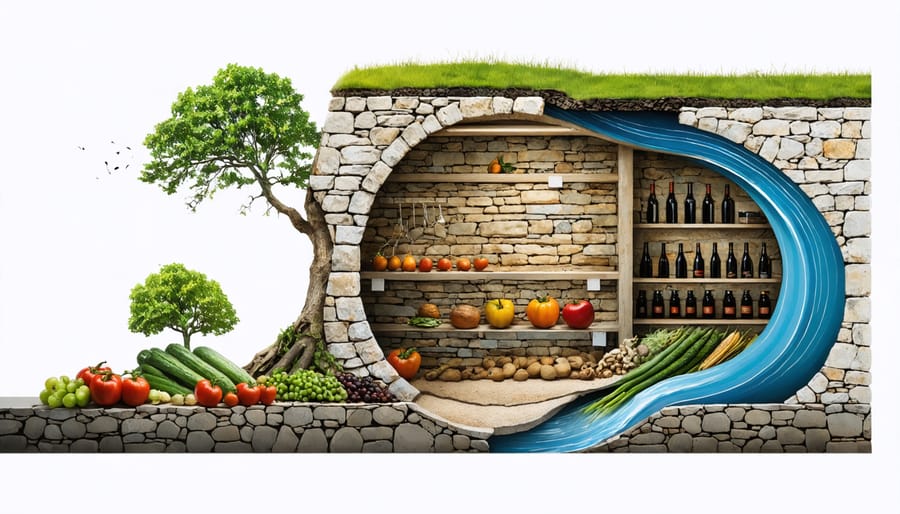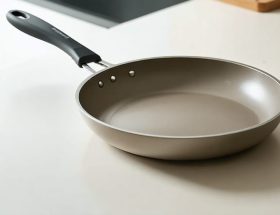Preservation storage, one of humanity’s oldest and most effective methods of food conservation, continues to revolutionize modern sustainability practices. Ancient civilizations discovered that natural stone chambers could maintain consistent temperatures and humidity levels, creating ideal conditions for preserving food without electricity. Today, these time-tested principles are experiencing a renaissance as architects and homeowners integrate stone-based storage solutions into contemporary designs.
From wine cellars carved into limestone to innovative root cellars utilizing granite’s thermal mass properties, stone preservation storage offers a compelling blend of historical wisdom and modern efficiency. These systems can reduce energy consumption by up to 60% compared to conventional refrigeration while maintaining optimal preservation conditions for fruits, vegetables, wines, and other perishables.
The growing interest in sustainable living has sparked renewed attention to preservation storage techniques, particularly in regions where traditional knowledge meets cutting-edge design. Whether incorporated into new construction or retrofitted into existing structures, stone-based storage solutions represent a crucial intersection of environmental consciousness and practical functionality. This natural approach to food preservation not only honors ancestral wisdom but also addresses contemporary challenges of energy conservation and food security.
The Science Behind Stone-Based Preservation
Thermal Mass Properties
The thermal properties of stone make it an exceptional material for preservation storage, particularly in maintaining stable temperatures for food items. Natural stone’s high thermal mass allows it to absorb and release heat slowly throughout the day, creating a naturally regulated environment that helps preserve perishables longer.
This temperature-regulating capability stems from stone’s dense molecular structure, which can absorb significant amounts of heat energy before its temperature changes substantially. During warmer periods, stone absorbs excess heat from the surrounding air, keeping the storage space cooler. Conversely, when external temperatures drop, the stored heat is gradually released, helping maintain consistent temperatures within the storage area.
This natural temperature regulation is particularly effective in root cellars, wine caves, and traditional food storage rooms. Modern applications of stone in preservation storage often incorporate these principles into contemporary designs, creating energy-efficient storage solutions that require minimal artificial climate control. The stability provided by stone’s thermal mass can help reduce energy costs while maintaining optimal preservation conditions for various food items.
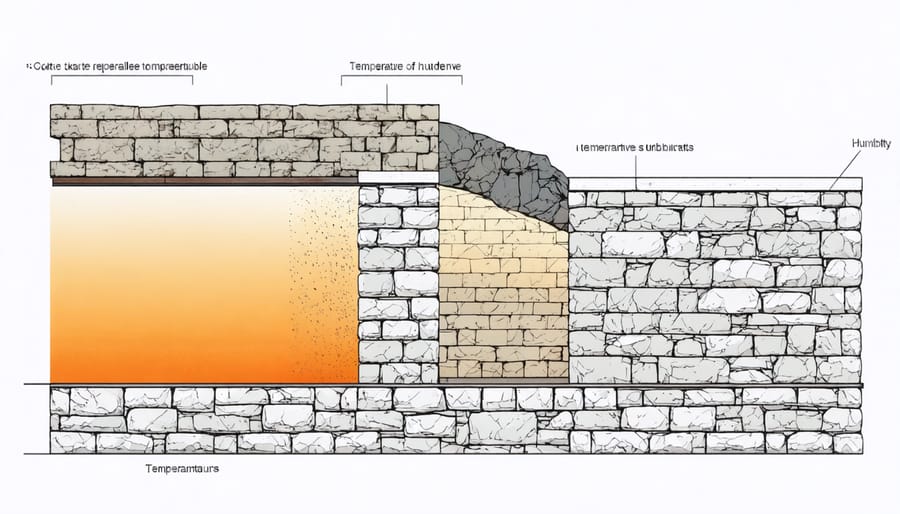
Natural Humidity Control
Natural stone plays a crucial role in maintaining optimal humidity levels within preservation storage spaces, thanks to its inherent ability to regulate moisture. This natural material acts as a buffer, absorbing excess moisture when humidity levels are high and releasing it when the air becomes too dry. This characteristic makes stone particularly valuable for preserving foods, wines, and other perishable items that require consistent humidity levels.
The porosity of stone allows it to maintain relative humidity levels between 50-70%, which is ideal for many storage applications. Different types of stone exhibit varying degrees of moisture regulation capabilities. For example, limestone and sandstone are particularly effective at moisture absorption and release, while granite provides more moderate humidity control.
In modern storage facilities, stone walls and flooring work in conjunction with proper ventilation to create a naturally balanced environment. This passive humidity control system reduces or eliminates the need for energy-intensive mechanical humidification systems, making stone storage an environmentally sustainable solution. The material’s natural properties continue to function effectively for decades, requiring minimal maintenance while providing consistent performance.
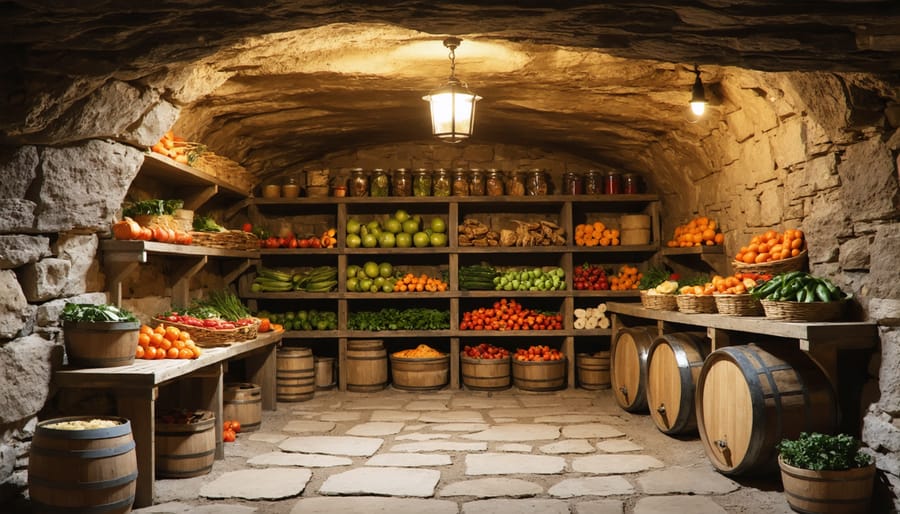
Best Stone Types for Food Preservation
Marble Storage Solutions
Marble’s natural thermal properties make it an excellent medium for food preservation storage. The dense crystalline structure of marble maintains consistent temperatures, creating an ideal environment for preserving perishables without relying on electrical cooling systems. This characteristic has been utilized for centuries, from ancient Mediterranean cellars to modern-day applications.
In contemporary settings, marble storage solutions offer multiple benefits for both residential and commercial spaces. The stone’s natural cooling properties can help maintain temperatures between 50-60°F (10-15°C), perfect for storing wines, cheeses, fruits, and vegetables. Additionally, marble’s low porosity helps regulate humidity levels, preventing excess moisture that could lead to food spoilage.
Modern marble storage installations often incorporate ventilation systems to enhance their effectiveness. Popular applications include wine cellars, cheese caves, and root cellars. The stone’s durability ensures these storage solutions remain functional for decades while requiring minimal maintenance.
For optimal preservation results, experts recommend using marble slabs at least 2 inches thick and ensuring proper air circulation. The stone’s natural antibacterial properties also contribute to a cleaner storage environment, making it particularly suitable for dairy products and fresh produce.
Beyond its functional benefits, marble storage solutions add aesthetic value to spaces while reducing energy consumption compared to conventional refrigeration systems. This combination of practicality, sustainability, and visual appeal makes marble an increasingly popular choice for both traditional and contemporary food preservation applications.
Granite and Other Natural Stones
While granite remains a popular choice for preservation storage due to granite’s unique properties, several other natural stones offer excellent alternatives with distinct preservation characteristics. Soapstone, known for its superior thermal mass, maintains consistent temperatures longer than most other stones, making it ideal for long-term food storage applications. Its non-porous surface naturally resists bacteria and requires minimal maintenance.
Marble, though more delicate than granite, excels in maintaining cool temperatures and has historically been used in dairy storage. Its natural cooling properties make it particularly effective in humidity-controlled environments. However, its susceptibility to acid etching requires careful consideration of stored items.
Slate offers outstanding durability and natural temperature regulation capabilities, with the added benefit of being naturally non-slip when textured. Its layered structure provides excellent insulation properties, while its density helps maintain stable environmental conditions.
Quartzite, often confused with manufactured quartz, is a natural stone that combines the aesthetic appeal of marble with durability similar to granite. Its crystalline structure provides excellent temperature retention and resistance to temperature fluctuations, making it suitable for both modern and traditional preservation applications.
Each stone type requires specific maintenance protocols to maximize its preservation potential and longevity. Regular sealing and proper cleaning methods ensure these natural materials continue performing optimally in preservation applications.
Modern Applications of Stone Storage
Stone Root Cellars
Modern stone root cellars combine time-tested principles with contemporary design elements to create efficient, sustainable food storage spaces. These structures utilize natural stone’s thermal mass properties to maintain consistent temperatures between 32-40°F (0-4°C) and humidity levels of 85-95%, ideal conditions for preserving fresh produce.
The construction typically begins with a carefully selected site, preferably on a north-facing slope for optimal temperature control. The foundation consists of a concrete footer topped with stone walls at least 12 inches thick. Local fieldstone or quarried stone blocks are commonly used, with careful attention paid to proper drainage and vapor barriers to prevent moisture issues.
Essential design features include a well-planned ventilation system with intake and exhaust vents to regulate air flow and humidity. Modern cellars often incorporate adjustable vents and monitoring systems to maintain optimal storage conditions throughout the year. A properly constructed entrance with an insulated door and airlock vestibule helps prevent temperature fluctuations.
Interior organization maximizes storage efficiency through sturdy wooden shelving, vegetable bins, and hanging racks. Many contemporary designs include separate storage zones for different produce types, as various fruits and vegetables require slightly different storage conditions.
The integration of natural lighting through small, well-placed windows provides functionality while maintaining temperature stability. Some modern cellars also feature solar-powered ventilation fans and LED lighting systems, combining traditional stone construction with energy-efficient technology.
Stone-Based Cooling Systems
Stone-based cooling systems represent a remarkable fusion of ancient wisdom and modern technology in preservation storage. These innovative solutions harness the natural thermal properties of stone to create efficient, sustainable cooling environments. Much like traditional root cellars, modern stone cooling systems utilize the material’s inherent ability to maintain consistent temperatures and regulate humidity levels.
The integration of stone elements in contemporary cooling solutions typically involves strategically placed stone walls, floors, or storage units that act as thermal mass regulators. When combined with proper ventilation systems, these stone components can maintain temperatures between 50-60°F (10-15°C), ideal for preserving fruits, vegetables, and wines.
Modern applications include temperature-controlled wine cellars with limestone walls, granite-lined produce storage rooms, and innovative stone-based kitchen tools designed for refrigeration. Some cutting-edge designs incorporate water features that enhance the cooling effect through evaporative cooling principles.
The energy efficiency of stone-based cooling systems is particularly noteworthy, often reducing electricity consumption by 30-40% compared to conventional refrigeration systems. This sustainability factor, combined with the material’s durability and low maintenance requirements, makes stone-based cooling an increasingly popular choice for both residential and commercial applications. The aesthetic appeal of natural stone adds value while serving a practical purpose, creating beautiful yet functional storage spaces that stand the test of time.
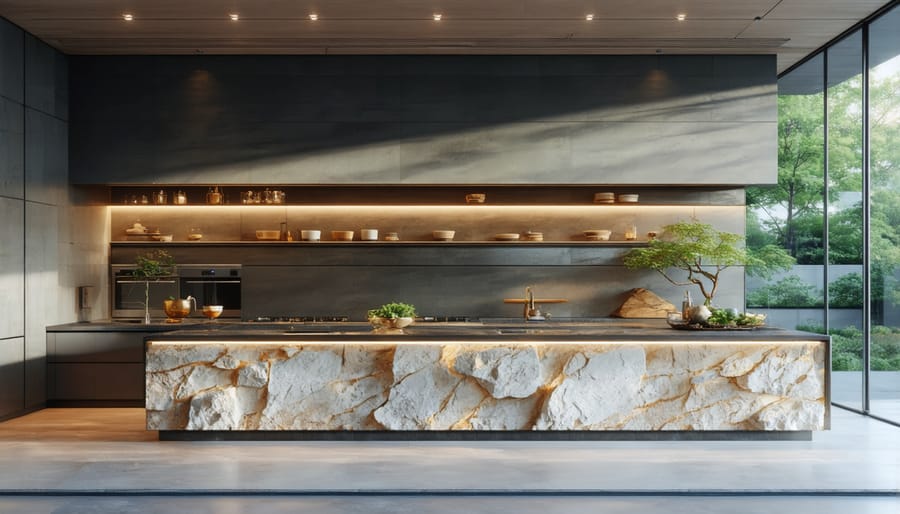
Maintenance and Best Practices
Regular maintenance and adherence to best practices are crucial for ensuring the optimal performance of preservation storage systems. Begin by conducting monthly inspections of your stone storage area, checking for any signs of moisture infiltration, structural damage, or temperature inconsistencies. Clean the stone surfaces regularly using pH-neutral cleaners to prevent the buildup of mold or bacteria that could compromise stored items.
Maintain proper ventilation by keeping air circulation pathways clear and functional. If your system includes mechanical ventilation, service it according to manufacturer recommendations, typically every six months. For natural ventilation systems, ensure vents remain unobstructed and adjust them seasonally to optimize airflow.
Temperature monitoring is essential – install reliable thermometers at different points within the storage space and check readings daily. Record these measurements to track any concerning patterns or fluctuations. The ideal temperature range typically falls between 50-60°F (10-15°C), though specific requirements may vary based on stored items.
Humidity control plays a vital role in preservation effectiveness. Use hygrometers to monitor moisture levels and maintain relative humidity between 50-65%. Install dehumidifiers if necessary, particularly in regions with high ambient moisture. Address any water seepage immediately to prevent damage to both the structure and stored items.
For underground storage systems, ensure proper drainage around the perimeter to prevent water accumulation. Regularly inspect and clean drainage channels, particularly after heavy rainfall. Apply appropriate sealants to stone surfaces every 3-5 years to maintain their protective properties.
Organization within the storage space is equally important. Implement a rotation system for stored items, ensuring older products are used first. Maintain adequate spacing between items to allow proper air circulation and prevent cross-contamination. Use food-grade storage containers when appropriate and label everything clearly with contents and storage dates.
Keep detailed maintenance logs documenting all inspections, repairs, and environmental readings. This documentation helps identify patterns and potential issues before they become serious problems, ensuring your preservation storage system remains effective and efficient long-term.
Stone-based preservation methods represent a remarkable fusion of ancient wisdom and modern sustainability. By harnessing the natural properties of stone, these storage solutions offer energy-efficient alternatives to conventional refrigeration while maintaining optimal conditions for food preservation. The growing interest in sustainable architecture and eco-friendly storage solutions suggests a promising future for stone-based preservation techniques. As technology advances, we can expect to see innovative hybrid systems that combine traditional stone storage principles with smart monitoring and climate control. These developments will not only help reduce energy consumption but also provide reliable, cost-effective storage solutions for both residential and commercial applications. The timeless durability of stone, coupled with its natural temperature-regulating properties, positions it as a key player in the future of sustainable food preservation.

